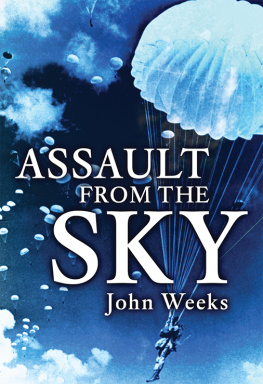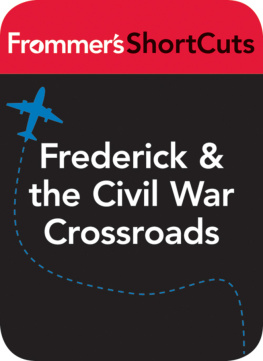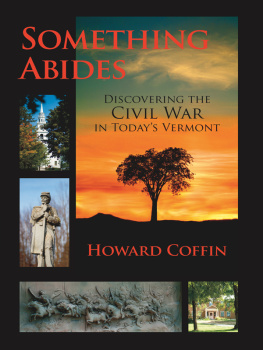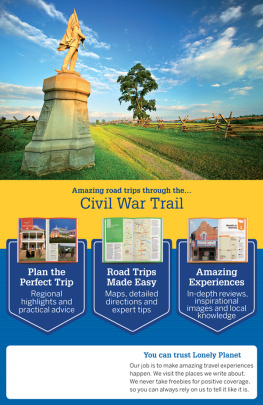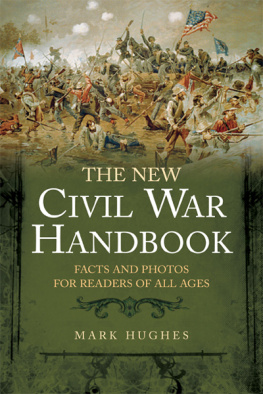
Copyright 2016, 2009 by Michael Weeks
Cover and interior photographs by the author unless otherwise specificed
Maps by Mapping Specialists The Countryman Press
Book design and composition by Faith Hague Book Design
All rights reserved
For information about permission to reproduce selections from this book,
write to Permissions, The Countryman Press,
500 Fifth Avenue, New York, NY 10110
For information about special discounts for bulk purchases, please
contact W. W. Norton Special Sales at or
800-233-4830
The Library of Congress has cataloged the printed edition as follows:
Names: Weeks, Michael, author.
Title: The complete Civil War road trip guide : more than 400 sites
from Gettysburg to Vicksburg / Michael Weeks.
Description: Second edition. | Woodstock, VT : The Countryman
Press, 2016. | Original edition has subtitle: Ten weekend tours and more
than 400 sites, from Antietam to Zagonyi's Charge. |
Includes bibliographical references and index.
Identifiers: LCCN 2015044803 | ISBN 9781581573374 (pbk.)
Subjects: LCSH: United StatesHistoryCivil War,
1861-1865BattlefieldsGuidebooks. | United StatesHistoryCivil
War, 1861-1865Campaigns. | BattlefieldsUnited StatesGuidebooks. |
Historic sitesUnited StatesGuidebooks.
Classification: LCC E641 .W45 2016 | DDC 973.7dc 3
LC record available at http://lccn.loc.gov/2015044803
ISBN 978-1-58157-553-8 (e-book)
The Countryman Press
www.countrymanpress.com
W. W. Norton & Company, Inc.
500 Fifth Avenue, New York, N.Y. 10110
www.wwnorton.com
To my parents,
Donald and Karen, the two smartest people I know,
who instilled their love of learning in me
and
To my wife, Charlotte, for
her patience, encouragement, and love
CONTENTS


THERE IS NO BETTER way to learn than through experience. It is easy to read about the Civil Warthere have been thousands of books dedicated to its battles, its personalities, its politics, and its impact on history. But none of these books (including this one) can take the place of being there, seeing the landscape, walking the fields, and communing with the ghosts of the people who made this war a defining moment in Americas history. Anyone can read about the first battle at Fredericksburg, review the battle maps and troop movements, and understand the tactics and strategies of the battle. But when you are able to stand behind the stone wall at the top of Maryes Heights, with the same view that a Confederate soldier had watching Ambrose Burnsides Union troops storm up the hill, you not only begin to better understand the scenes that played out on these hallowed grounds, but you also begin to ask the really important questionshow could this have happened? Why? Using all your senses to experience history brings the facts together and helps them sink in. It involves you wholly, and you learn in a way that no book, no photograph, and no map is able to teach.
This book is designed to help you get to those places that will help you experience the Civil War in a way that no history book can. It will take you to all the most important sites of the warwhether they still exist or notand help you understand why these places are important. It will help you to learn more by seeing and feeling, and will hopefully inspire you to want to see more to deepen your understanding. When youre ready for that, this book will help you get to those places, too.
This book is going to give you guidance on what to see. It will help lay out the best way to see the most critical sites of the war. But it is not going to restrict itself to the Gettysburgs and Chattanoogas of the war. It is also going to visit the places that might not be so legendary today, but were just as importantbattlefields like Fort Pulaski, Prairie Grove, and New Madrid.
In addition to the battlefields, there are hundreds of other historic sites and places where action took place. In some cases the only indication that these places even existed is a sign or a roadside memorial. In other cases there is no memorial at all. But that doesnt necessarily mean that its not worth going out of your way for. Some of these places are in absolutely unspoiled country, and with a little information, you can re-create the entire scene before your eyes without any distractions or interruptions. And yes, some of them are now literally underwater, or are parking lots for shopping centers. But if you are interested in a certain general, or are following a campaign, you might want to see every place on the map. This book will help you get to those places and tell you what to expect.
The book will also give you just enough to know why you might want to see these places, and why theyre important. But you wont get a complete history lesson. How much you want to get out of your experience is your decision. Some people can drive up to the edge of the Grand Canyon, look in awe for five minutes, and be satisfied. Others will feel left out if they dont learn the name of every rock formation, study the geology, and hike down to the bottom to camp for three days. Youll get enough to get there, know what youre looking at, and why youre looking at it. What you do from there is up to you, and I hope that you gain from what you learn.
One other note: One of the reasons that I wrote this book is to increase the amount of visitation at all the sites, large and small. The more awareness there is about them, the more likely it is that existing sites will be funded and improved and new sites will be created. When you go, let people know why youre therestay and have a bite to eat, talk to some of the locals, and show them that having history in their backyard brings dollars into the local economy. If you live in one of the locations described in this book, and little to nothing exists to relate the great history that took place there, I hope that you will be inspired to raise your voice, point it out to your community, and get them started in preservation efforts. There is still much work to be done.

WHERE TO BEGIN
There are a lot of Civil War battlefield guides out there. Most are designed to help you get the most out of your experience at a major battlefield. You are dropped in Gettysburg, Pennsylvania, and told in great detail about the reasons the battle occurred, given a map or two, and shown what you can see. Then you are picked up, dropped in Shiloh, Tennessee, and told similar information.
While these guidebooks are absolutely essential, the book youre holding is different. All the tours recommended in this book can be done in either a weekend or a long (three- to four-day) weekend and will guide you to the most important and well-preserved sites of the war. How much time you want to spend at these sites is up to you. You can pick which ones you see and which you skip. But this book is going to give you so many options that you will be able to tailor your trips to exactly what you want to get out of them.
BEFORE YOU GO: PLANNING YOUR TRIPS
There are a couple of resources you can pick up that can add a lot to your experiences. One of them is even FREE.
The Civil War Battlefield Guide, Second EditionThis book, created by an environmental nonprofit group called The Conservation Fund and edited by Frances H. Kennedy, is a must-have for anyone wanting a one-volume description of the battles of the Civil War. The book has concise and detailed descriptions of 384 battles, contains wonderful maps, and includes essays by well-known historians such as James McPherson and Ed Bearss. It is well organized, thorough, and would make a valuable addition to any Civil War library.
Next page




